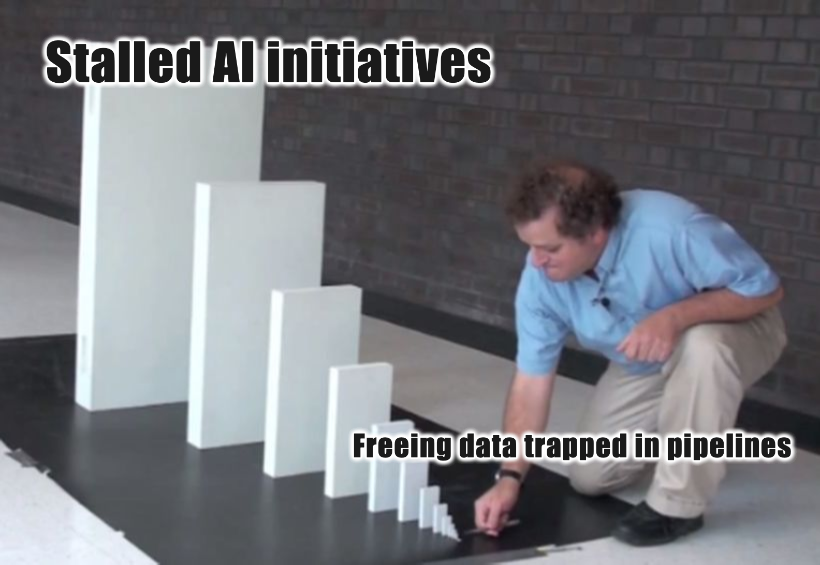
A ritual playing out in boardrooms everywhere: the new data strategy presentation. This time it’s different. This time we’ll capture the value. The slides are beautiful. The architecture diagrams are comprehensive. Everyone nods. Nobody believes it.
We’ve been here before. At least three times, in fact.
Big Data? That was 2012. Hadoop was going to change everything. We built data lakes that became data swamps. We hired data scientists who spent 80% of their time cleaning data. Dan Ariely’s quote captured it perfectly: “Big data is like teenage sex: everyone talks about it, nobody really knows how to do it, everyone thinks everyone else is doing it, so everyone claims they are doing it.”
Then Machine Learning. That was 2016. Data scientists underwent a rebrand as ML engineers. We bought new platforms. We talked about feature stores and model drift. But somehow, those game-changing ML models never quite changed the game, some never even made it to production.
Now, 2025, and we’re doing it again with AI. Same movie. New marketing. We’re building vector databases and RAG pipelines. We’re hiring prompt engineers. We’re promising transformation. And deep down, everyone knows how this ends.
Nobody wants to admit it: The problem was never the technology. Big Data worked. Machine Learning works. AI works. What doesn’t work is our ability to get data to these systems in a usable form, at the right time, in the right shape.
Your data team knows this. They’ve known it for years. Your “real time” dashboard is actually batch data from yesterday. The single source of truth isn’t actually a single source, or truthful. Changing a single field in a report means updating seventeen pipelines that nobody fully understands anymore.
Vendors know it too. Every new platform promises to be the “unified solution” that finally fixes everything. The data warehouse that acts like a lake. The lake that acts like a warehouse. The lakehouse that does both, poorly.
Even your executives know it. That’s why the CEO’s first question is “Can we actually do that?” with a tone that suggests they already know the answer.
Each wave of innovation fails for the same reason: we’re building on a foundation designed in 1985. Every Big Data initiative, every ML platform, every AI agent eventually crashes into the same wall. The data they need is trapped in pipelines built for specific use cases that no longer exist.
We extract data for the BI team’s quarterly reports. When the ML team needs that same data in a different shape, we build another pipeline. When the AI team needs it streaming instead of batch, we build another pipeline. Three years later, nobody remembers why pipeline number 47 exists, but everyone’s afraid to turn it off.
This isn’t a technology problem. It’s an architecture problem. We’re using a hub and spoke model in reverse, where every spoke is a custom built, brittle connection that breaks the moment requirements change.
What if the next wave is different? Not another layer of technology promises, but a rethink of how data moves?
At Matterbeam, we’ve watched this pattern with our customers. They come to us thinking they need better ETL. They leave realizing they don’t need ETL at all. One customer told us, “We changed our whole company strategy based on what we can do with Matterbeam.” That’s not something you say about a new pipeline tool.
The shift is simple but profound: Stop building pipelines for specific use cases. Start collecting data in its natural form, storing it immutably, and transforming it only when and how you need it. One collection, infinite uses. No more asking, “Can we get that data?” because the answer is always yes, and in minutes, not months.
When Broadlume wanted to build a new product feature using data, they didn’t spend six months building pipelines. They pointed Matterbeam at their existing data streams and had it running in two weeks. When they needed that same data for other use cases, each one took days or weeks, not months.
You can keep playing the game. Hire consultants to design your AI strategy. Build more pipelines. Buy more platforms. Wait for the next wave of technology promises. Your teams will nod along, knowing it won’t work, but playing their part in the theater.
Or you can acknowledge what everyone already knows: the strategy isn’t working because the foundation is broken. Fix the foundation, and suddenly those Big Data promises, those ML dreams, those AI ambitions become achievable. Not in some distant future, but now.
The lie isn’t that data can transform your business. The lie is pretending your current approach will get you there.
Your AI ambitions don’t have to wait. Matterbeam streams data to AI tools in hours — collect once, use infinitely, no pipeline building required.
Get started with Matterbeam | Talk to our team